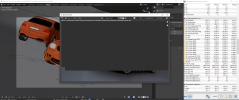I tested power reporting deviation during blender run, and minimum was 81.3%. This was at full stock settings

Then i ran the same test with -0.1V core voltage offset. Minimum value was 67.6%

Are these values bad? Can I do anything about it?
Why is PRD lower with negative voltage offset applied? Is measure with offset reliable?

Then i ran the same test with -0.1V core voltage offset. Minimum value was 67.6%

Are these values bad? Can I do anything about it?
Why is PRD lower with negative voltage offset applied? Is measure with offset reliable?
